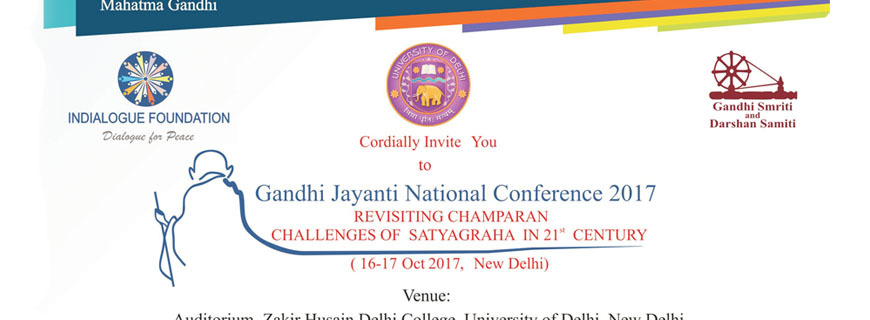Gandhi Jayanti National Seminar, 2017
On
REVISITING CHAMPARAN
CHALLENGES OF SATYAGRAHA IN 21st CENTURY
(16-17, Oct 2017)
Organised by
Indialogue Foundation
Gandhi Study Circle, Zakir Husain Delhi College (Morning & Evening), University of Delhi
Gandhi Smriti and Darshan Samiti
Concept Note
The Champaran movement of Mahatma Gandhi marked a revolutionary landmark in the history of India. It was exactly hundred years back in 1917 that Gandhi introduced to the Indian polity a unique methodology of taking on oppression with a force more powerful than all the physical might put together. Gandhi called it Satyagraha. It was through deliberation, public engagement and persuasive power that Gandhi took upon the task of addressing the grievances of rural masses in Champaran.
The Champaran satyagraha was the first struggle that Gandhi undertook on Indian soil after his incredible 20-year long movement for the defence of Indians’ rights in South Africa. It was followed quickly by the Ahmedabad workers’ strike against indigenous mill owners and by the Kheda Satyagraha against revenue enhancements, both in 1918; and then the all-India April satyagraha of 1919 against the Rowlatt Acts and, finally, the non-cooperation and Khilafat movement of 1920-22. It represented a bold and courageous experiments to unshackle farmers from exploitation and substantially improve the agrarian situation.To improve the abysmal living conditions of people in Champaran Gandhi initiated a variety of constructive action programs. These included efforts towards basic education, skill development, empowerment of women, better sanitation etc. At its core the movement stood as an ideal for constructing a social order based on harmony, reconciliation, understanding and deepening of public reasoning.
The Champaran movement will always remain as the crucial starting point for defining a new phase of Indian politics led by unique experience of Satyagraha. The outcome of Champaran heralded the dawn of a non-violent liberation movement in India which gained strength during successive phases of struggle for independence under the leadership of Mahatma Gandhi. The whole architecture of the Champaran Satyagraha assumes enormous significance in the present context. Today we are witnessing a world of increased turbulence. There has been a spurt in the incidence of violence and conflicts in different parts of the world including India. The polarisation on gender, class, caste, religion has gained unprecedented heights. Satyagraha, despite its fairly wide application, remains inadequately understood today. Revisiting the Champaran therefore becomes crucial and seminal. It is important to seek a fresh inquiry of the complex canvas and narrative of Satyagraha in 21st century.
The primary objective of this two day conference is to provide a platform for constructive dialogue and deliberation for academicians, researchers, policy makers, and students on some of the issues and problems posed above.
Some of the broader themes to be discussed include:
Champaran Satyagraha 1917 :Reflections from History
Theoretical Basis and Practical Dimensions of Satyagraha
Contextual Explorations on Satyagraha : Class, Caste and Gender
Present Education System and Gandhian Satyagraha
Satyagraha and perspectives on contemporary conflicts and Peace
Nation Building and Satyagraha
The seminar will be a two-day event starting from October 16th, 2017.The seminar will be held in Zakir Husain Delhi College, University of Delhi.
Page Hits–1434

